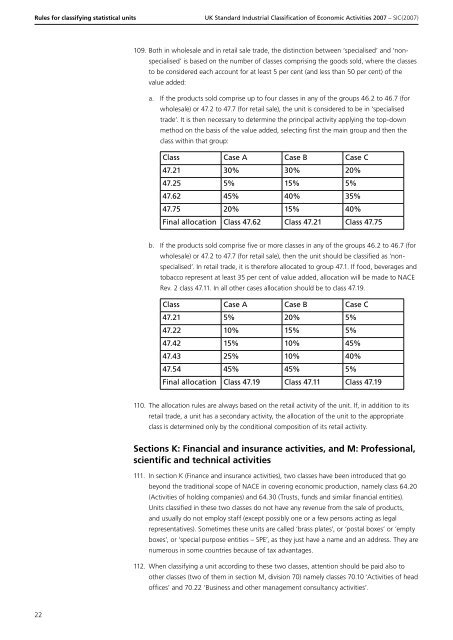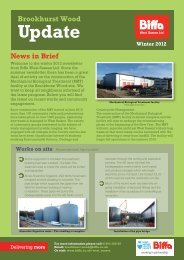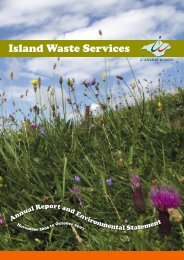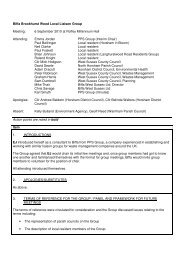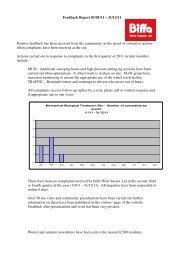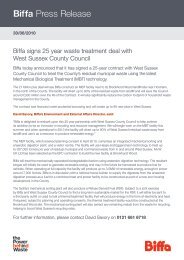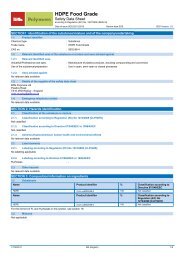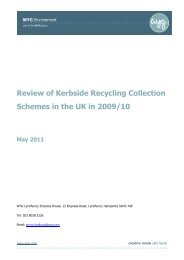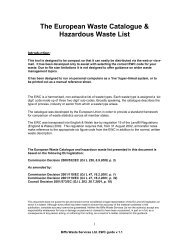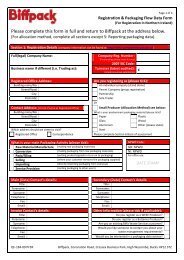detailed explanation for each SIC code - Biffa
detailed explanation for each SIC code - Biffa
detailed explanation for each SIC code - Biffa
Create successful ePaper yourself
Turn your PDF publications into a flip-book with our unique Google optimized e-Paper software.
Rules <strong>for</strong> classifying statistical units<br />
UK Standard Industrial Classification of Economic Activities 2007 – <strong>SIC</strong>(2007)<br />
109. Both in wholesale and in retail sale trade, the distinction between ‘specialised’ and ‘nonspecialised’<br />
is based on the number of classes comprising the goods sold, where the classes<br />
to be considered <strong>each</strong> account <strong>for</strong> at least 5 per cent (and less than 50 per cent) of the<br />
value added:<br />
a. If the products sold comprise up to four classes in any of the groups 46.2 to 46.7 (<strong>for</strong><br />
wholesale) or 47.2 to 47.7 (<strong>for</strong> retail sale), the unit is considered to be in ‘specialised<br />
trade’. It is then necessary to determine the principal activity applying the top-down<br />
method on the basis of the value added, selecting first the main group and then the<br />
class within that group:<br />
Class Case A Case B Case C<br />
47.21 30% 30% 20%<br />
47.25 5% 15% 5%<br />
47.62 45% 40% 35%<br />
47.75 20% 15% 40%<br />
Final allocation Class 47.62 Class 47.21 Class 47.75<br />
b. If the products sold comprise five or more classes in any of the groups 46.2 to 46.7 (<strong>for</strong><br />
wholesale) or 47.2 to 47.7 (<strong>for</strong> retail sale), then the unit should be classified as ‘nonspecialised’.<br />
In retail trade, it is there<strong>for</strong>e allocated to group 47.1. If food, beverages and<br />
tobacco represent at least 35 per cent of value added, allocation will be made to NACE<br />
Rev. 2 class 47.11. In all other cases allocation should be to class 47.19.<br />
Class Case A Case B Case C<br />
47.21 5% 20% 5%<br />
47.22 10% 15% 5%<br />
47.42 15% 10% 45%<br />
47.43 25% 10% 40%<br />
47.54 45% 45% 5%<br />
Final allocation Class 47.19 Class 47.11 Class 47.19<br />
110. The allocation rules are always based on the retail activity of the unit. If, in addition to its<br />
retail trade, a unit has a secondary activity, the allocation of the unit to the appropriate<br />
class is determined only by the conditional composition of its retail activity.<br />
Sections K: Financial and insurance activities, and M: Professional,<br />
scientific and technical activities<br />
111. In section K (Finance and insurance activities), two classes have been introduced that go<br />
beyond the traditional scope of NACE in covering economic production, namely class 64.20<br />
(Activities of holding companies) and 64.30 (Trusts, funds and similar financial entities).<br />
Units classified in these two classes do not have any revenue from the sale of products,<br />
and usually do not employ staff (except possibly one or a few persons acting as legal<br />
representatives). Sometimes these units are called ‘brass plates’, or ‘postal boxes’ or ‘empty<br />
boxes’, or ‘special purpose entities – SPE’, as they just have a name and an address. They are<br />
numerous in some countries because of tax advantages.<br />
112. When classifying a unit according to these two classes, attention should be paid also to<br />
other classes (two of them in section M, division 70) namely classes 70.10 ‘Activities of head<br />
offices’ and 70.22 ‘Business and other management consultancy activities’.<br />
22


